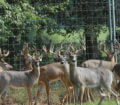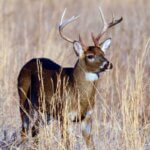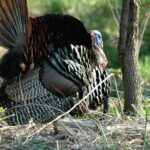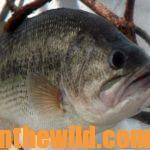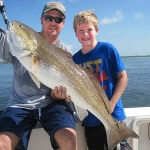Editor’s Note: If you understand what causes the rut, when the rut occurs, and what bucks do during the rut, you can increase your odds for bagging a mature whitetail each season. Of course, all across the U.S., rutting times are different. As many myths exist about the whitetails’ mating season as there are proven scientific facts. To determine what the rut means to the deer hunter and how to hunt the rut more effectively, let’s ask wildlife scientists.
Well-known deer biologist and head of the Wildlife Management program at Southwest Texas Junior College, Bob Zaiglin always waits 15-20 minutes to let the woods settle down before he begins to rattle. “You may have spooked the deer doing into the area you want to rattle. Waiting until the woods are still for awhile before you go into your rattling sequence is the most-productive method of hunting. I begin rattling by pounding the antlers into the ground and alternate the antler pounding. What I’m trying to imitate is the hoof action of bucks stomping the ground and the running of the deer. Often a buck is pursuing a doe, and the doe will keep running from him. I want to create a picture in the deer’s mind that the first sound he hears is that of a buck chasing the doe, and she isn’t willing to stand for the buck.
 “When two bucks are preparing for a sparring match, they pound the ground with their feet. I use the rattling antlers first to imitate the sound of pounding deer hooves. I’ll give this pounding sound for 30 seconds to one minute. Many times I’ve brought deer in strictly to the pounding sound before I ever start rattling antlers together. The next step is to clash the antlers together loudly. Something many hunters forget when they’re using rattling antlers is that the deer have feet as well as antlers. Often I’ll clash the antlers together, pound the ground, clash the antlers together again and twist them. I’ll carry on this sequence for 1-1/2-minutes. Again, the critical key is to pound the ground with antlers in between the rattling.
“When two bucks are preparing for a sparring match, they pound the ground with their feet. I use the rattling antlers first to imitate the sound of pounding deer hooves. I’ll give this pounding sound for 30 seconds to one minute. Many times I’ve brought deer in strictly to the pounding sound before I ever start rattling antlers together. The next step is to clash the antlers together loudly. Something many hunters forget when they’re using rattling antlers is that the deer have feet as well as antlers. Often I’ll clash the antlers together, pound the ground, clash the antlers together again and twist them. I’ll carry on this sequence for 1-1/2-minutes. Again, the critical key is to pound the ground with antlers in between the rattling.
“I know plenty of hunters have brought in bucks by just clashing antlers together, but when you’re attempting to fool a wily whitetail, the smart hunter will do everything he can. Pounding the ground is just something extra that helps the deer paint a better picture of a fight in his mind and may be the little extra required to pull him into your gun sights. I believe that one of the reasons my tactics work so well on big bucks is that I make the antler rattling sound as realistic as possible.
“Also I pay attention to what’s happening around me. Many hunters will look down at the ground when they pound it, or they’ll watch the antlers when they rattle them. But what I’ve learned is that if a big buck is coming in to angler rattling, he’ll run in and take a quick look, and when he doesn’t see a fight, he’ll run away just as rapidly. If the hunter is not ready to take the deer when the buck comes in, the sportsman may see that trophy buck but never get a shot. Therefore, during this period of clashing antlers and pounding the ground, look for the buck, and have your rifle at hand. This sequence should last only about 1-1/2-minutes.
 “To be able to simulate a deer fight with rattling antlers, you must understand what actually takes place when bucks battle. Two, 200-pound deer make a loud, clashing sound when they run together and hit. But then when they lock up, a pushing match results. The only time you’ll hear the sound of antlers clashing again is when one buck stumbles and falls, and the other buck attempts to move in and take advantage of this opportunity. The buck that has fallen can regain his footing. Then there will be another clash of antlers. However, most of the sounds you’ll hear in a buck fight will be the grinding sounds of antlers. So, when you’re rattling, remember to grind more with the antlers and clash less.
“To be able to simulate a deer fight with rattling antlers, you must understand what actually takes place when bucks battle. Two, 200-pound deer make a loud, clashing sound when they run together and hit. But then when they lock up, a pushing match results. The only time you’ll hear the sound of antlers clashing again is when one buck stumbles and falls, and the other buck attempts to move in and take advantage of this opportunity. The buck that has fallen can regain his footing. Then there will be another clash of antlers. However, most of the sounds you’ll hear in a buck fight will be the grinding sounds of antlers. So, when you’re rattling, remember to grind more with the antlers and clash less.
“After the 1-1/2-minutes of clashing, grinding and pounding the ground, I’ll start looking around to see if I can spot a deer. I’ll examine the terrain slowly, much like a turkey hunter, because the deer may be watching me. I’ve found that about 60 percent of the deer hunters rattle in are never seen. After I’ve taken 30 seconds or so to observe what’s happening, I begin pounding the ground again with the antlers to simulate a deer stomping, and I start raking the brush with the antlers. Many hunters don’t understand that rubbing a tree with the antlers is one of the most-effective ways to bring in a buck. often I’ve brought in deer by only raking the antlers up and down the side of a tree, which can be done for as long or for as short a time as the hunter feels he should. After you’ve raked the bushes and the brush, you’ve completed a sequence of rattling.”
 To learn more about hunting deer with John E. Phillips’ Amazon Kindle eBooks, print books and Audible books (the latest Audible is “How to Hunt Deer Like a Pro”) and Nook books, click here at https://johninthewild.com/books/#deer. You can type in the name of the book and download it to your Kindle, and/or download a Kindle app for your iPad, SmartPhone or computer. For a free download on how to make jerky from venison to provide a protein-rich snack, choose “How to Prepare Venison Jerky: The Ultimate Snack Food” at johninthewild.com/free-books.
To learn more about hunting deer with John E. Phillips’ Amazon Kindle eBooks, print books and Audible books (the latest Audible is “How to Hunt Deer Like a Pro”) and Nook books, click here at https://johninthewild.com/books/#deer. You can type in the name of the book and download it to your Kindle, and/or download a Kindle app for your iPad, SmartPhone or computer. For a free download on how to make jerky from venison to provide a protein-rich snack, choose “How to Prepare Venison Jerky: The Ultimate Snack Food” at johninthewild.com/free-books.


